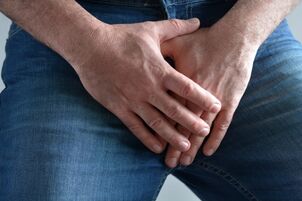
Prostatitis, like any other disease, presents with certain symptoms. It is important for a man to know exactly the first signs because they indicate a visit to the doctor and further examinations. We will talk about how the different forms of the prostate gland and first aid measures are manifested in the article.
Prostate and prostatitis in brief
An adult male prostate gland is a glandular organ consisting of two lobes and a capsule and an adjacent prostate urethra. The prostate performs 3 functions at once:
- Regulates sperm density by producing prostate juice and diluting the ejaculate with it.
- Blocks the urethra during orgasm.
- Participates in the production of certain hormones or regulates their levels in the body.
If a man's reproductive system is not functioning, the first signs are of these functions of the prostate.
Penetration of the pathogenic microflora into the prostate or its damage, hypothermia, as well as stagnant processes, inflammation begin. In this case, the blood microcirculation is disrupted, and the outflow of lymph, venous blood, and prostate secretion deteriorates. This leads to the development of edema and an increase in the size of the gland. As a result, the tissues are compressed, the man has a heavy sensation in the perineum or mild painful pain in the lower abdomen - the first sign of impending prostatitis.
The clinical picture depends largely on the form of the inflammatory process and its causes.
Symptoms of acute bacterial prostatitis
It is very difficult to miss the first symptoms of acute prostatitis - they appear suddenly and develop quickly. It often takes 2-4 days between the onset of an inflammatory process and the first sign. In this case, the clinical picture depends on the stage of the disease.
In this case, the clinical picture depends on the stage of the disease.
Acute catarrhal inflammation
The first sign of this type of prostatitis will be a feeling of difficulty in the perineal region as well as increased urination at night. Body temperature does not rise in this form because men often ignore existing problems or try to treat them on their own, thus provoking the next step.
Acute follicular inflammation
At this stage, the first signs of prostatitis will be more pronounced. Many men no longer risk self-healing but seek medical attention. Complaints will be very different:
- There is dull pain in the perineum, it may radiate to the coccyx or anus.
- Urination is painful, the man has difficulty, which means that acute urinary retention can develop.
- Pain during bowel movements that causes the man to not be able to go to the toilet.
These are the first symptoms of follicular acute prostatitis, in addition to 38 degrees fever, general depression, weakness, depression. The person becomes irritable, libido decreases, erectile dysfunction may occur.
These symptoms persist and in the absence of appropriate treatment, the next stage develops.
Acute parenchymal inflammation
The inflammatory process has already spread to the parenchymal tissue and is therefore developing rapidly. The first thing a sick person notices is a rise in body temperature to a high value (from 39 ° C), chills, dry mouth. The pain becomes severe, throbbing, and can be felt in the perineum and lower back, in the abdomen, and in the genitals.
Urination also changes. One first notices a intermittent stream and then, due to severe pain, is unable to empty his bladder at all. If you do not call an ambulance, you will show signs of indigestion - bloating, constipation, abdominal pain of various localizations. The smelly mucus leaves the anus.
You may understand that it began with a characteristic feature of parenchymal acute prostatitis: the pain subsides when you lie on your back and lift your legs. This is a clear indication of the urgent need for medical care.
First Signs of Chronic Prostatitis

Chronic prostatitis is a long-term inflammation of the prostate gland, so the first signs are most often acute. However, a man expects periods of exacerbation from time to time, and here he needs to understand what symptoms accompany them. Most often, men complain of the following health problems:
- Burning sensation around the penis, especially during ejaculation or urination;
- Mild pain in the perineum may radiate to the pubic area;
- Slight increase in body temperature.
In chronic prostatitis, erectile dysfunction and the ability to participate in the child's conception inevitably begin. This is due to a deterioration in the function of the prostate, which results in a change in the blood supply to the penis and a deterioration in the quality of the sperm.
At the first signs of an exacerbation of prostatitis, a cure should be given. It is not recommended to use tablets previously prescribed by a doctor without prior examination.
Clinical picture of the disease
Regardless of the form and causes of the inflammatory process, a person will have a noticeable symptomatic triad, only the intensity of their manifestation will differ. Prostatitis is always accompanied by urinary incontinence, pain and erectile dysfunction.
Urine associated with prostatitis is excreted dropwise or intermittent. Sometimes the beam is sprayed and it is problematic for a man to stand to alleviate a small need. Urinary stimuli are more common at night, especially closer to breakfast. If there are stones in the prostate, the urine may turn pink due to the mixture of blood.

With prostatitis, the urethra and other cells accumulate in the urethra and bacteria can multiply. This leads to a burning sensation that intensifies during urination or ejaculation.
Pain cannot be avoided either. Depending on the severity of the pathological process, these may be:
- whining;
- stupid;
- shot (pulsating).
Their most common localization is the perineal region, just below the testicles. Radiation from the coccyx, sacrum, pubis, penis is not excluded. In addition, there may be pain in the anus, especially during pushing, because a person often encounters constipation.
As for body temperature, it rarely rises to 38 degrees. The exceptions are parenchymal and purulent prostatitis, in which this indicator can reach 40 degrees and may be accompanied by chills, severe depression, and sometimes confusion. In such cases, the temperature associated with prostatitis endangers the patient's life.
First aid for prostatitis
Treatment of prostatitis is possible on an outpatient basis if we are not talking about purulent processes. But even in this case, it cannot be done without having to consult a doctor for examination and choice of treatment tactics. However, the first signs of prostatitis can occur when a person is unable to call an ambulance, so you need to know some of the principles of first aid.

- When the temperature rises above 38 degrees, you can take an antipyretic.
- To reduce pain, it's a good idea to lie on your back and raise your legs as high as possible (lean against a wall or furniture).
- In particularly severe pain, you can drink anticonvulsants or insert suppositories.
You should see a doctor as soon as possible, while you should tell the reception which medicines you have taken and in what doses.
Traditional methods should only be used after confirmation of the diagnosis and only with the permission of the treating physician.
How are prostatitis manifested in analyzes?
Prostatitis refers to diseases that do not have their own symptoms. For example, a burning sensation during urination may be urethritis and pain in the lower abdomen - in appendicitis or cystitis. Therefore, the final diagnosis is made not on the basis of the patient's complaints but on the basis of the results of laboratory tests on blood, urine, semen and prostate juice. Data from rectal examination, TRUS, and several other instrumental methods are also considered.
Prostatitis is characterized by the following diagnostic features:
- Presence of bacteria or fungi in urine and prostate fluid.
- Presence of leukocyte cells in urine and blood tests.
- Decreased number of leukocyte particles in prostate secretion in the background of increased number of leukocytes;
- Blood in urine or semen;
- Decreased red blood cell deposition rate during blood tests.
- Prostate pain, changes in size and texture.
- Change in echogenicity, granularity, contour based on TRUS results.
The combination of these signs with well-being-related complaints allows us to make an accurate diagnosis, which means that treatment will be prescribed correctly. The patient's quality of life, rate of recovery, and in some cases, his or her life depend on it.
Conclusion
Knowing the first signs of prostatitis in men can help you navigate changes in well-being in a timely manner and take action in advance. When pain started in the perineum, urine flow decreased and urination stimuli became more frequent - this gives rise to suspicion of prostatitis and gives a signal to a doctor. In these cases, it is better not to self-heal.
























